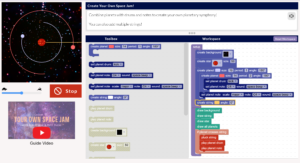This week, I took a deep dive into the cosmic world of coding, music, and astronomy, and it was out of this world! I discovered an activity from Hour of Code called NASA Space Jam, where I got to make a musical solar system. Yes, you heard that right, planets making music!
What made this activity cooler? I didn’t even know how to code before! This coding activity was beginner-friendly, visualizing and inspiring, but I still learned a lot with real coding skills and a whole new outlook on space.
What is NASA Space Jam?
NASA Space Jam is a fun, interactive coding activity where you can learn basic coding principles to make a musical model for the solar system. Each of the planets becomes it’s own music: While using this website you can:
You can program various planets to make unique musical sounds
Can adjust their speed and rhythm to create loops and melodies
You can can personalize your solar system and listen to how it sounds in motion
This kind activity is a great entry to coding, an idea that combines technology with arts. It made me recall a lot from Chrome Music Lab, another coding website where you can code music and visuals together. If you’re into mixing science and sounds together, this is definitely up your alley!

Where Music Meets Astronomy
The most surprising part for me was seeing how music and astronomy joined together through coding. As I arranged each orbit and note, it felt like I was directing a cosmic orchestra. Every loop, sound and movement was mine to build.
This coding activity also helped me better understand how coding is used in space simulations. I got super curious and explored NASA’s real-world tools such as Eye on the Solar System, where you can look at the actual NASA mission data in 3D. This hands-on experiment between what I was doing and what scientists are doing right now made it feel even more significant.
Why This Activity is Important in Astronomy
This activity wasn’t about making music, it was a start for me to understand how programming works in cosmic exploration. Timing, arranging, stimulation, and modeling are used in NASA for real missions like the James Webb Telecope and Mars Rovers.
What I Learned This Week
This wasn’t just about playing, it was about learning. Here’s what I learned from my experience with coding:
- Loops and Repetition: I used loops to duplicate musical patterns, just like how satellites rotate around planets
- Variable & Functions: I learned how changing values such as speed, variable affected how each planet sounded.
- Object-Oriented Logic: Every planet had its own properties, (like how a real code object has), and I used the functions to describe behaviours like playing the sounds when a planet moved
Imagination Through Coding: This has shown me how coding isn’t always about numbers and grammar. Coding can be used to tell stories, design art or even simulate the solar system
In addition, I also checked out the NASA STEM YouTube Channel to see how engineers and scientists use coding in real life missions. Super amazing stuff, and it connected to what I was learning in a small, super fun way!